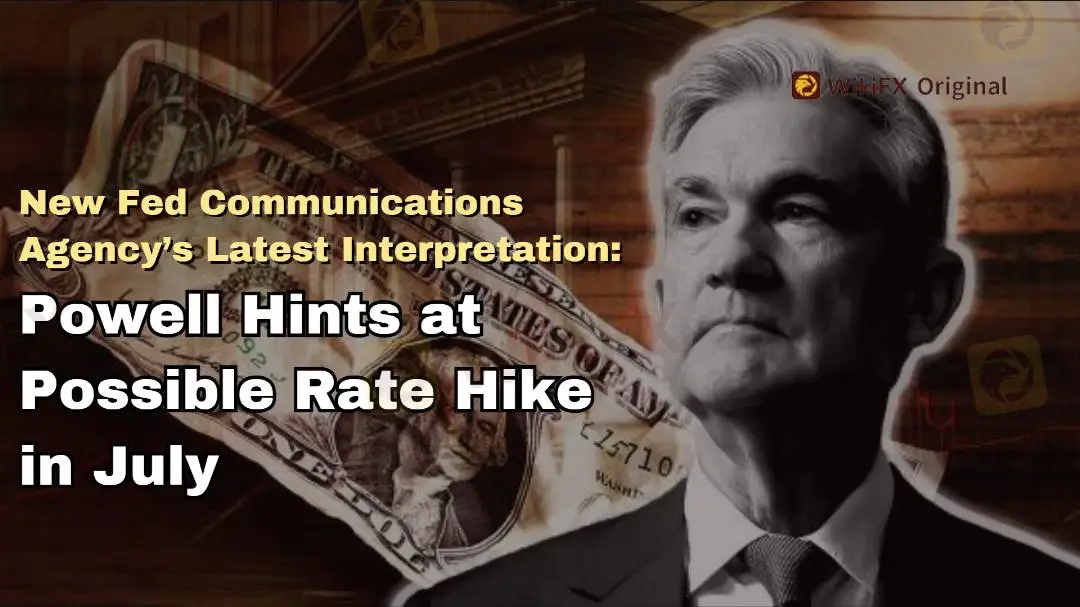简体中文
繁體中文
English
Pусский
日本語
ภาษาไทย
Tiếng Việt
Bahasa Indonesia
Español
हिन्दी
Filippiiniläinen
Français
Deutsch
Português
Türkçe
한국어
العربية
New Fed Communications Agency’s Latest Interpretation: Powell Hints at Possible Rate Hike in July
Abstract:Latest interpretation from "New Fed Communications Agency": Powell has hinted that a rate hike in July is entirely possible

On Thursday, June 15, local time, journalist Nick Timiraos, known as the “New Fed Communications Agency,” wrote an article indicating that after Powell's press conference, many analysts have started to accept the potential action of “rate hike next month.”
It is worth mentioning that Timiraos attended the press conference yesterday and had an exchange with Fed Chair Powell during the Q&A session. Based on his observations, some analysts believe that Powell's remarks that day implied his stance to further hike rates at the July 25-26 monetary policy meeting.
On Wednesday, the Federal Reserve announced its decision to keep the federal funds rate target range unchanged between 5% and 5.25%, marking the first pause since the beginning of the aggressive rate hike cycle in March 2022. Over the past 15 months, the Fed has raised rates ten times, with a cumulative increase of 500 basis points.
However, the release of the “dot plot” at the same time created quite a stir in the market. Central bank officials projected a median interest rate of 5.6% by the end of the year, which is nearly 50 basis points higher than the current level of 5.00%-5.25%. This suggests that the Fed may hike rates twice more this year.
Timiraos mentioned that during Powell's first year as Fed Chair, the central bank had intermittently raised rates for a period of time. This aligns with a statement from the Chair yesterday, stating that the market should not view the pause in June as a “skip,” but rather as a “slower pace of rate hikes to allow the economy to adjust.”
Several analysts believe that this inadvertently revealed Powell's inclination towards a rate hike next month. Powell also referred to the July meeting as a “live” meeting, which, according to Timiraos, is a common phrase used by central bank officials, indicating a greater possibility of a rate hike.
Gregory Daco, Chief Economist at consulting firm EY, stated that Powell's remarks almost guarantee a rate hike in July. This also explains how he managed to convince dissenting officials within the central bank to ultimately vote in favor of maintaining the current rates.
Some voices suggest that the economic data leading up to the July meeting is unlikely to show weakness significant enough to reverse the course of rate hikes.
Tim Duy, Chief Economist at SGH Macro Advisors, mentioned that even if June's inflation is expected to slow down further due to used car prices, officials will argue that one month of improvement is not enough reason to pause the rate hikes.

Disclaimer:
The views in this article only represent the author's personal views, and do not constitute investment advice on this platform. This platform does not guarantee the accuracy, completeness and timeliness of the information in the article, and will not be liable for any loss caused by the use of or reliance on the information in the article.
Read more

Alleged Concerns with TradeEU.global's Trading Practices
An individual trader has come forward with allegations of an unfavourable experience while using the services of the broker TradeEU.global.

Lured by False Promises: Malaysian Driver Lost RM218K to an Investment Scam
A 49-year-old e-hailing driver in Malaysia fell victim to a fraudulent investment scheme, losing RM218,000 in a matter of weeks. The scheme, which falsely promised returns of 3 to 5 per cent within just three days, left the individual financially devastated.

SFC Freezes $91M in Client Accounts Amid Fraud Probe
SFC freezes $91M in client accounts at IBHK, SBI, Monmonkey, and Soochow over suspected hacking and market manipulation during unauthorized online trades.

Italian Regulator Warns Against 5 Websites
The Italian regulator, CONSOB has issued a warning against five websites offering unauthorized financial services. This regulatory action aims to protect the public from fraudulent activities.
WikiFX Broker
Latest News
Saxo & Portuguese Bank Partnership
SEC Fines Broker-Dealers $275K for Incomplete SAR Filings
What Makes Cross-Border Payments Easier Than Ever?
Trader Exposes Unethical Practices by STP Trading
Lured by False Promises: Malaysian Driver Lost RM218K to an Investment Scam
FTX Sets March 2025 Timeline for Creditor Payouts: What It Means for Investors
What is an Economic Calendar? How it works
Italian Regulator Warns Against 5 Websites
Mastercard's 2030 Vision: Biometric-Driven, Tokenized Payments
SFC Freezes $91M in Client Accounts Amid Fraud Probe
Currency Calculator


